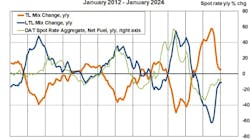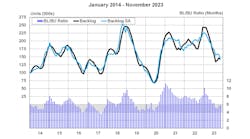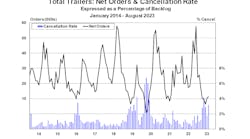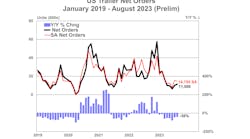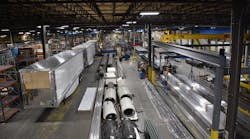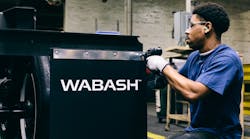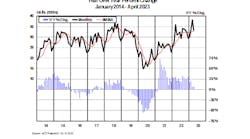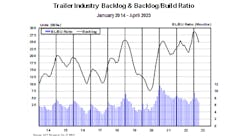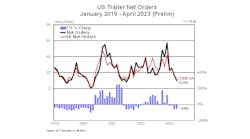What a difference an ocean can make.
On the other side of the Atlantic, the truck and trailer market has been booming, benefiting trailer manufacturers and trade show managers alike.
Thanks in large part to a booming economy in Europe, the Royal Professional Organization of Flemish Road Haulers and Logistics Service Providers (SAV) reached new highs in attendance and exhibitor participation with its recent biennial trade show. Attendance was up 11% over the 2005 edition of the show. The 25,000 attendees came from 39 countries. They saw displays from 173 companies and strolled through 376,740 square feet of exhibits.
Trailer 2007, held November 23-27 at the Kortrijk Xpo in Kortrijk, Belgium, displayed Europe's latest answers to a changing market and new regulations.
Many of the concerns facing commercial truck and trailer customers in Europe are similar to the challenges of fleets in North America. The Netherlands and Germany, for example, are experimenting with “eco-combies,” an effort to achieve greater allowable lengths through the use of doubles sets. A more productive transportation system is needed to address an acute shortage of truck drivers, a shortage that will worsen in the coming years as one-third of the population retires. Railroads, however, are opposing efforts to liberalize size and weight laws.
“The market is incredibly strong right now,” says Lode Verkinderen, secretary-general of SAV. “Backlog for trucks and trailers here has reached 18 months. We calculate that every 1% growth in the economy causes the transportation segment to grow 1.2%. We anticipate a 40-45% increase over time.”
The economy in Eastern Europe in particular has been growing rapidly, and the residents of those nations need trucks and trailers, Verkinderen says.
“Eastern Europe has no tradition of local manufacturers,” Verkinderen says. “Those countries either had no manufacturing, or they have communist-era production. The manufacturers in Western Europe now have an entire continent to supply.”
Verkinderen characterizes the Benelux — the economic union of Belgium, the Netherlands, and Luxemburg — trailer industry as small and innovative. An estimated 100 trailer manufacturers operate in Belgium alone, he says, and they produce low-volume, highly customized orders for their customers.
“Customers set high standards for price and value, and they expect trailers to be able to be loaded and unloaded quickly,” Verkinderen says. “Because of this, a lot of manufacturers will test market their products here. If the product is successful here, it will be successful elsewhere.”
The next edition of the show will be held in 2009. Plans are already underway to expand the trailer show to include a limited number of trucks.
“On the road, a trailer seems lost without a truck in front of it,” show organizers say. “At the Trailer 2009-edition, the trailers will remain ‘in front’ and thus uphold their status as prime product.”
One of the highlights of the show is the announcement of its “Best Vehicle” and “Best Accessory” awards. Details of those two award-winning products, along with other trailers and truck bodies are:
And the winner is… The TPX model dump trailer won the “Best Vehicle” award at Trailer 2007. The judges selected the trailer for its attention to “weight, safety, and functionality.”
The TPX 7.6 dump trailer has a conical-shaped box that is designed to improve material flow during the dumping cycle. The fully aluminum body is assembled from patented aluminum extrusions and fabricated aluminum plate. The floor is made of a single sheet of 8 mm 5383-H34 aluminum sheet. That particular alloy was chosen for its resistance to wear.
Sides are made of 2.4 mm 5086-H24 aluminum sheet. They are supported in part by 170-mm-wide extruded aluminum top rails. The nose slopes 20° from vertical to enhance material flow. The nose is reinforced at the corners for additional stability.
The body rides on a full-length frame, the backbone of which consists of two 200-mm extruded aluminum I-beams. The hinge is integrated into the chassis to improve stability. The trailer rides on three nine-tonne DaimlerChrysler trailer axles and six Goodyear LHT tires mounted on steel wheels. Electronic braking is provided by a Wabco 2S/2M system. The manually operated Jost landing gear, with its compensating S feet, is designed for use with air suspensions.
The 24-volt electrical system powers LED side marker lights on both sides of the trailer.
The aluminum trailer is chemically cleaned and degreased before painting. A variety of colors are offered in addition to a natural finish.
STAS of Waregem, Belgium, is the manufacturer. The company has applied for a patent on the design. STAS (Strong Trailers at Your Service) spent about a year designing and testing the TPX 7.6. STAS has sold about 300 of the trailers in the year that the TPX has been on the market.
Container Quick-Lock locks containers quickly. The patented container locking mechanism won the “Best Accessory” award at Trailer 2007. The Container Quick-Lock is an automatic system for locking containers on trailers that is activated as the container is loaded onto the chassis. It was developed by the Dutch company Q-Trade and the Belgian company Logi-D.
The judges for the award selected the product because it is “a simple innovation that provides a lot of added value in the areas of safety and user-friendliness.” The judges also liked its attractive price, kept low because the lock is purely mechanical action. It does not rely on air or hydraulic power to operate.
At the trailer show, the Container Quick-Locks were mounted on container trailers from D-TEC, but the locks can be used for all types of container trailers, swap bodies, and trains. This is because the Container Quick-Lock is suitable for any type of ISO container. According to Rony van Britsom, one of the developers, the Container Quick-Lock will also lead to considerable reductions in labor costs.
“Given the amount of time that drivers spend at the moment locking the twist-locks on the containers, the savings over the whole lifespan of a trailer can be 20,000 euros or more, thanks to the semi-automatic Container Quick-locks,” van Britsom says.
The container lock is a product of Q-Trade BVBA, Zoersel, Belgium.
One big caulk gun. Van Hool displayed its new Europiston tank trailer, a product built to transport and unload up to 26,300 liters of not-so-liquid materials such as printing ink and silicon. Much like a caulk gun, the trailer contains a piston that forcibly removes the contents of the single-compartment tank. The piston is powered by air. However, it also is design to keep air away from the payload. The tank is made of 304 stainless steel. To work successfully, the tank must be perfectly round.
The company also displayed its Jumbo tanker, a 50-kiloliter tank built with three or more compartments. Made from 316L stainless steel, the chemical tank that Van Hool displayed has three compartments of 14,500/20,500/15,000 litres, with each compartment fitted with the necessary baffles for partial loads. The middle compartment is equipped with steam-heated top discharge. It is possible to load the compartment from ground level. The semi-trailer has a double heating circuit — one circuit for compartment and another for the remaining two compartments. The chassis is made entirely from stainless steel. In spite of being fully equipped, the tare weight of 8,800 kg is exceptionally low.
Tanks are but one product line for Van Hool NV, Koningshooikt, Belgium. Founded as a bus and coach manufacturer in 1947, the company has been manufacturing trailers since 1964. They include tanks, curtain-side vans, intermodal vans, container chassis, and swap bodies.
China comes to Europe. CIMC, the Chinese manufacturer and parent company of Vanguard National Trailer Corp in the U S, has strengthened its presence in Europe by acquiring 80% interest in Burg Industries — and its LAG subsidiary.
The acquisition, effective June 26, 2007, created CIMC Burg. CIMC Burg is under the direction of Peter van der Burg, president and CEO.
Burg products span the range of trailers, including refrigerated vans, dry freight vans, dumps, curtainside vans, tanks, containers, and container chassis.
Burg Industries presently covers 15 operating companies in five countries in Europe. Worldwide the enterprise employs almost 1,600 people, 700 of whom are employed in Belgium. Burg had sales of approximately 270 million Euros in 2007. LAG displayed several of its products at Trailer 2007, including this composite van trailer. Immediately behind it is a 45-ft refrigerated CIMC container.
Keeping cargo bottled up. Load security promises to be a major issue now that fleets can speed through safety inspections when their trailers have a safety certificate. DEKRA, an organization in Germany, will certify that specific trailers meet new standards intended to help keep cargo inside the trailer in the event of an accident. The standards — EN 12642XL — set specific strength requirements for the sidewall, nose, and rear of trailers.
To certify compliance, tests can be either static or dynamic. Industriële Carrosseriebouw Moyerson, a Belgian company based in Londerzeel, claims to be the first to offer fleets such a certification. To do so, Moyerson places an inflatable bladder inside the trailer, filling it to the specified pressure — representing 40% of the load that the trailer would carry. An inspector witnesses the test to validate that it was done correctly and that the trailer met the requirements of the standard.
Raising the roof (strength). The roofs of trailers are also part of the new cargo retention requirements being introduced in Europe. With curtainside vans the workhorse of the European dry-freight fleet, roof strength is a major consideration when complying with standards such as EN 12642XL. Passing the standard is not as simple as beefing up roof bows or adding an extra rivet or two because approximately 90% of curtainside vans are sold with sliding roofs, according to Erik Rogiers with Versus Omega BVBA.
When testing for compliance, the roof rail cannot deflect more than 30 mm when the test balloon is inflated to 10,800 kg and pushes against the side curtain.
Carapax is a new sliding roof system designed to meet the strength requirements of EN 12642XL. The result of a collaborative effort between three companies — Versus-Omega, Coatex, and Dynatex -the Carapax roof system uses Kevlar or similar aramid fibers for the sheet. Bonded to the sheet are roof bows made of PVC.
The key to the system is the series of omega-shaped plates that flex upward without hinges. They ride on rollers that are locked into an aluminum extruded top rail. Versus-Omerga supplies the roof system to major European trailer manufacturers, including Schmitz, Krone, and Kögel. A variety of designs are available, including the one shown here that uses a hand-powered hydraulic pump to raise the roof 400 mm. Versus-Omega, Opglabbeek, Belgium.
The Big One Mega is a new addition to the Big One line of curtainside trailers produced by Humbaur GmbH of Gersthofen, Germany. Tare weight of the Big One Mega is 6,890 kilograms, but it is rated at up to 39,000 kilograms GVWR. External dimensions push the limits — 13,900 mm overall length and 2,550 mm overall width. Side loading height without a raised roof is 2,820 mm, and the 2,925 mm for the rear door. A high-tensile steel ladder frame reduces weight. Bolted perforated cross members combined with special torsion struts add torsion rigidity. Complete frame is hot-galvanized throughout.
Humbaur has selected an SAF triaxle equipped with integral ventilated disc-brakes and air-ride suspension. Electronically controlled braking system with RSS active stability system and spring operated parking brake are standard. To meet the strength requirements of German regulations, the front wall is made of aluminum box section construction with forklift impact protection.
Tandem axle platform trailer from Fliegl Trailer weighs in at 2,900 kg (6,393 pounds) and can carry a payload of 8,900 kg (19,620 pounds). The 7,360-mm (24-ft) trailer is equipped with ABS brakes, 4-mm steel flooring, detachable drop sides, and counterbalanced galvanized loading ramps. Fliegl Fahrzeugbau GmbH, Triptis, Germany.
Under the limit… Container chassis from Dennison Trailers is designed to transport high-cube 40-ft and 45-ft containers and still reduce overall height to comply with Europe's four-meter (13'1” ft) limit. Based on the company's standard design that has been proven in the United Kingdom, the telescoping chassis can transport a variety of container length combinations, including single 30-ft, 40-ft, and 45-ft, along with swap bodies and other ISO containers. Narrow neck allows the container to sit below the neck. Front of the chassis extends 0.85 meters forward to accommodate a 40-ft tunnel container in the closed position or a 45-ft container in the extended position. Electronic braking, along with roll stability, and LED lighting all around are standard. The company's main plant is in Naas, Ireland.
Ag trailer is designed to transport potatoes and other products with a density of up to 1,300 kg per cubic meter. The manufacturer, Dewagtere Engineering NV of Roeselare, Belgium, specializes in producing trailers that can be unloaded with a conveyor belt, insulated or non-insulated designs, but offers a variety of other material-handling equipment — stationary equipment as well as trailers.
Electronically controlled trailer uses Bluetooth technology to steer the trailer's three axles and to raise and lower the loading ramps. Sending signals to the ramps and axles via a Bluetooth module helps reduce the likelihood that the trailer would be activated by nearby equipment such as cranes that are using the same signal.
The trailer has a 53-tonne payload rating. It is expandable from 20 meters to 30.6 meters and can transport 30-meter profiles. Overall width of the trailer also can be selected — from 2.5 meters to 3.2 meters. A dolly — also remote controlled — can be added. The trailer (and dolly) are available from Turbo's Hoet, a truck and trailer dealer with locations in France, Belgium, and Spain. It is a product of Constructuion de Vehicules Industriels, Longuyon, France.
Brick trailer. Kennis Trailers specializes in the manufacture of crane trailers for the construction industry — and particularly for transporting brick. Annually they produce over 100 semi-trailers mainly for customers in The Netherlands, Belgium, France, Germany, and the U.K. Crane trailers come standard with a reinforced bogie and either with one or two steering axles. Kennis is the largest of three subsidiaries of Nooteboom Holding. The Nooteboom Holding subsidiaries employ more than 450 people and sell approximately 1,400 vehicles annually. Their combined sales are almost € 100 million.
X-Steerings makes trailers much more maneuverable and reduces fuel consumption, according to Renders NV, Beerse, Belgium. The company says that tests conducted by Goodyear Europe and Volvo Belgium indicate that the patented steering system can improve fuel economy 4-8%.
High-capacity dump trailer can carry 50 cubic meters. It measures 10.5 meters long (34.4 feet), 2.43 meters wide (92.5 inches) and 2.2 meters high (87 inches). Made of Hardox steel, the trailer weighs 8,150 kilograms (17,967 pounds). It is produced by ATS Rauw, Büllingen, Belgium.
Wide open. Four-axle drop-deck curtainside trailer can transport high loads in a protected environment. Spreading rails on the gooseneck also help make it possible to transport widths up to five meters with the curtains closed. GVWR is 47,600 kilograms (104,938 pounds). Tare weight is approximately 11,500 kilograms (25,352 pounds). It is a product of Meusburger Fahrzeugbau GmbH, Eging am See, Germany.
Longer truck trailer combinations are considered essential to easing the shortage of drivers that Europe is facing. The “Eco-Combies” such as this one produced by Fliegl Fahrzeugbau GmbH, Triptis, Germany, has a tandem-axle tractor pulling a tri-axle trailer and a tandem-axle pup. Overall length is 25.25 meters (82.8 feet).
MaxiWay curtainside van has sides that expand laterally to allow oversize cargo to be loaded. Sides then move inboard to comply with width regulations. It is a product of Royen sa/nv, Soumagne, Belgium.
Removable tank body is a product of Atcomex Company NV, Gullegem, Belgium. The aluminum tank, built on a steel chassis, can carry 27 cubic meters within its three compartments.
Lightweight dump trailer combines compact capacity that its lower tare weight makes possible. The trailer has a 29-cubic-meter capacity (38 cubic yards), but it only weighs 5.32 tonnes (11,728 pounds). Geometry of the dump box adds to the capacity. The trailer is also available in 34-, 40-, and 48-cubic-meter capacities. It is a product of The MOL Group, Roesalare, Belgium. The group produces specialized trailers, including concrete mixer trailers, platforms, drop-decks, and heavy-haulers. Other divisions of the group manufacture custom truck chassis with configurations ranging from 4×4 to 10×10, railroad service trucks, yard tractors, refuse equipment, and custom fabricating.
Building the noise-compliant reefer. Because of the congestion of Western Europe, refrigerated fleets often deliver loads at night when the traffic is reduced. Studies indicate that fleets can reduce delivery times significantly — up to 50% in some cases — by making deliveries in the middle of the night.
However, in many cases, the stores where the deliveries are made have residences built on top of them. Occupants of those residences have complained to their governments, and the issue is getting consideration in several countries in Western Europe.
The Netherlands already has regulations in place. The Dutch regulations call for a 60-dbA noise limit for refrigerated trailers between 11 pm and 7 am. The noise level is measured with an open microphone over the course of a five-minute period. For additional information about the regulations, visit www.piek.org.
The regulations address all noise generated by the truck and trailer — not just the engine and refrigeration unit. As such, engineers are studying ways to reduce all types of ambient noise — including the opening and closing of doors, operation of liftgates, and impact of objects against the sidewalls of the trailer.
The result has been some significant changes in the way refrigerated trailers are manufactured and operated. Mirofret, a Spanish trailer manufacturer, displayed its “Super Quiet” refrigerated trailer — the company's response to these restrictions. Included as part of the design:
-
An enclosed, undermount refrigeration unit. To slash noise produced by the refrigeration unit, Mirofret selected a Carrier refrigeration unit installed inside a foam-lined box underneath the trailer. The engine serves as a generator that supplies electricity to the electric motors that drive the compressor and the fan.
-
New liftgate that includes a redesigned hydraulic system, including new motor and hoses.
-
Redesigned floor. The floor is now smooth, reducing the amount of sound generated when the trailer is unloaded. To further reduce noise, the floor is covered with a special coating.
-
Composite load bars produce less noise on impact than comparable products made of metal.
-
A GPS system on the tractor that automatically reduces engine RPM when the truck gets into a predefined area.
-
A backup alarm that emits a frequency that does not travel as far as conventional backup alarm signals.
-
Steerable axles make the trailers more maneuverable.
Mirofret is based in Alicante, Spain. The trailer was displayed in the Betras exhibit. Betras Carrosserieën bv, Venlo, Netherlands, is the Mirofret dealer for the Benelux region.
